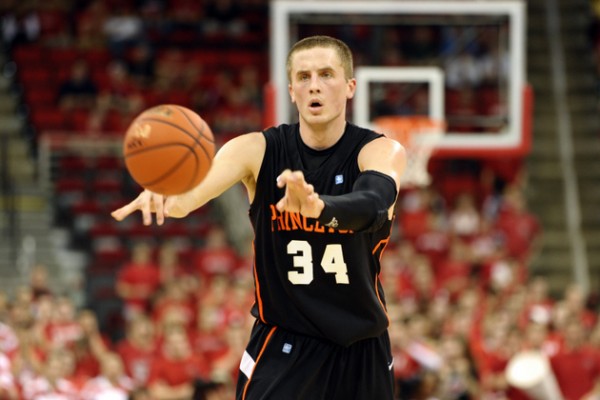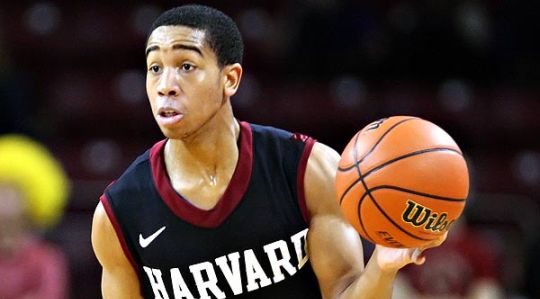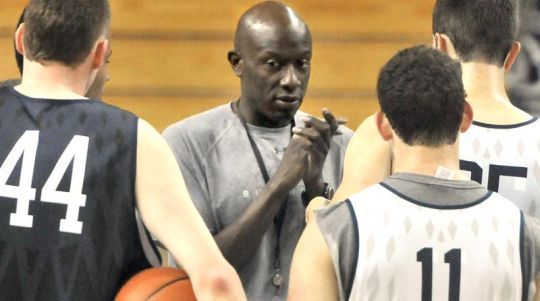CIO… the Ivy League
Posted by Brian Goodman on December 21st, 2012Michael James is the RTC correspondent for the Ivy League. You can also find his musings on Twitter at @mrjames2006 and @ivybball.
Looking Back
- Princeton’s Collapses – Ken Pomeroy just added another stellar feature to his site – an advanced stat box score for past games as well as the scoring by 10-minute increments that he labels “quarters.” The Tigers might not want to look at that latter piece of information, especially the numbers under Q4. In the four games prior to last night’s convincing win over Rider, Princeton was outscored 74-50 in the final 10 minutes of games and blew leads of eight (at Wagner), six (vs. Drexel) and 11 points (vs. Fordham). Throwing in the Northeastern game, where Princeton lead by 10 with 10 minutes to play, the Tigers could be looking at a completely different record if it could just salt away games in which it has big leads. That’s also the reason why it would be foolish to underestimate Princeton on the basis of its 4-6 mark to this point.
- Winner Winner – Harvard clawed back from eight points down early in the second half and three points behind with just five minutes to play, only to watch Boston University’s D.J. Irving hit a jumper with 19 seconds left to stake the Terriers to a one-point lead. Then came another chapter in a storybook rookie season for the Crimson’s Siyani Chambers. The 6’ point guard attacked the paint looking to set up a teammate for a good look, but came up empty and was forced almost to the short corner. The Boston University defenders went flying by, leaving Chambers all alone to nail a game-winning jumper. The basket gave Chambers 21 points on the night – the second time in three games he hit that mark. For a position that was supposed to be Harvard’s Achilles heel heading into the season, the former Minnesota Mr. Basketball has turned it into one of its strengths.
- Strength Against Strength – There are several ways to illustrate the split between the Ivy League’s top three teams and its bottom five squads. None may be more striking than the results against Power Six competition. In five games against Power Six opponents, Columbia, Harvard and Princeton are 2-3 with an average scoring margin of zero. The remaining five teams have an average scoring margin of -21 over eight games, and none of those contests finished within single digits. There are still six such games left to be played for the Ivies this year (five by the bottom five), so that stat is still subject to some change, but with over two-thirds of the contests already having been played, it’s unlikely the gap will close significantly.
Reader’s Take
Power Rankings
- Harvard (5-4) – It’s not that the Crimson has necessarily overachieved, but rather that fellow favorites Columbia and Princeton have stumbled so badly at times that pushes Harvard back to the top spot. The Crimson is hardly without flaws, especially on the defensive end. Starting forwards Steve Moundou-Missi and Kenyatta Smith have struggled in all facets of the game, leaving Harvard to turn to a four-guard lineup with only 6’6” forward Jonah Travis anchoring the paint. Still, the Crimson has managed to be the league’s best defensive rebounding team and, while it is second-to-last in two-point field goal percentage allowed, it balances that out by refusing to put opponents on the free throw line. The efficiency in converting missed shots into stops and forcing turnovers has made Harvard an above-average defensive team. Combine that with the best offense in the league by over five points per 100 possessions, and it’s clear why the Crimson has slowly become the Ivy favorite.
- Columbia (5-4) – The league’s best win, a 75-57 victory at Villanova, still belongs to the Lions, but it’s the four games immediately surrounding that one that had kept most from hopping on the Columbia bandwagon. Losses to Marist and Long Island, as well as a miserable trip to San Francisco in which the Lions scraped past an NAIA team before getting soundly defeated by the host Dons have evoked painful memories of last year’s shockingly disappointing Ivy campaign. Columbia has been better in December, especially on the defensive end, as it held American to 42 points on 53 possessions and clamped down on a very good Bucknell team until foul trouble derailed its hopes. Much like last season, the Lions boast the best effective field goal percentage against of any Ivy team. Last year, though, the defensive magic abandoned Columbia during league play – something the Lions can’t let happen again.
- Princeton (4-6) – It’s certainly possible that the Tigers are just doing their usual non-conference rope-a-dope thing again, waiting for the rest of the league to think they’re extremely vulnerable before turning it on in Ivy play. If so, they’re being quite convincing. A deeper look reveals that the issues might be real, though. Princeton has two three-point threats, Will Barrett and Clay Wilson, but unlike the graduated Douglas Davis, neither has the ability to create his own shot. Junior guard T.J. Bray has the ability to break a defense down, but hasn’t been able to do so effectively. It should be no surprise that senior forward Ian Hummer is using an overwhelming portion of his team’s possessions and carries a ridiculous assist rate. While Hummer has handled that massive load with average efficiency, the Tigers need to develop other weapons or their Ivy title hopes will begin to fade.
- Cornell (4-7) – Here are the Adjusted Offensive Ratings (points per 100 possessions adjusted for quality of opponent) for each Big Red game this season: 87, 95, 94, 64, 76, 124, 97, 84, 90, 90,75. Of the remaining seven Ivies, only Dartmouth and Penn have failed to post multiple games above 100 and only the Big Green has been worse on the offensive end on average. If anything, the problem might have more to do with tactics than talent. Cornell is a well-below average shooting team from long range, yet it ranks in the Top 100 in three-point attempts as a percentage of overall field goals. As a team the Big Red is one of the Top 100 free throw shooting squads in the nation, but it’s hard to get attempts by launching copious threes instead of attacking the rim. Cornell also hovers around the Top 10 in percentage of bench minutes played – something that makes little sense when you consider that the Big Red’s quality offensive options are limited in number.
- Pennsylvania (2-7) – Of the Quakers’ 17 non-conference games, only five will have come against teams outside the Top 200, so wins were expected to be few and far between. If anything, Penn has done a good job of avoiding any embarrassing showings despite the brutal schedule, but the Quakers frequent, lengthy cold spells offensively have doomed otherwise solid performances. The young squad is turning the ball over once every four possessions, and its three highest usage players are a combined 21-of-80 from long range. Penn has been good enough defensively to keep itself in games, but its struggles in cleaning the glass (worst in the Ivies) and keeping opponents off the free throw line (also worst in the Ivies) have yielded free points that the Quakers just can’t spare.
- Yale (4-7) – The Bulldogs could really use line changes between the offensive and defensive ends of the floor. While it’s hard to glean much from plus-minus at all, especially this early in the season, the Bulldogs players are unique in that all but one is either a positive contributor on offense and a negative contributor on defense, or vice versa. That leaves Yale coach James Jones to decide between chasing points on one end and preventing them on the other. Ultimately, the talent isn’t there on either side of the floor to perform either task adequately, and the Bulldogs are on pace to be the worst team Coach Jones has placed on the court since the very beginning of his tenure over a decade ago.
- Brown (3-5) – Looking at the five worst teams in the Ivy League, it’s hard to point to one that has a better starting five than the Bears, especially with a fully healthy Tucker Halpern in the lineup. Beyond those five guys, though, Brown has very little to offer with only nine eligible players on the roster and only six above offensive replacement level. At least the non-conference slate has been spaced out. As most know, Ivy League play won’t be as kind with back-to-back Friday-Saturday games that force teams’ benches to do some heavy lifting. It’s entirely possible that the Bears will have as many as four players who could be mentioned for some sort of All-Ivy honors – guards Sean McGonagill and Matt Sullivan as well as forwards Rafael Maia and Halpern – and yet will have to struggle to avoid losing double-digit games in league play.
- Dartmouth (2-7) – The results weren’t all that bad, especially considering what the rest of the Ivies have been doing lately. The Big Green took Vermont to the wire on the road, losing by just two, and put a bit of a scare into Arizona State, trailing by just seven with seven to play before the Sun Devils salted the game away with a 15-3 run. The problem is that Dartmouth is now just 2-3 when holding opponents below an Adjusted Offensive Rating of 94, while the rest of the league is 14-8. Only severely offensively challenged teams should lose games when their defense has played so well, as even the other seven mostly terrible offensive squads have managed a .636 winning percentage in such contests. None of the Big Green’s players has an effective field goal rate over 50 percent, and three of Dartmouth’s key reserves are mired in the 20s. It’s a down year for offense across the league, but the Big Green is flirting with Pomeroy-era records for scoring inefficiency.

Once Again, Ian Hummer And The Tigers Are Sleepwalking Through Their Non-Con Schedule, But Will They Impress In Conference Play?
Looking Ahead
- December 22 – Bucknell at Princeton, 7:00 PM – At some point, the surprisingly poor performances like the home loss to Northeastern and the neutral site defeat at the hands of Fordham stop becoming blips on the radar that can be written off, but rather true signals that the Tigers aren’t quite the Ivy favorite everyone thought them to be. Assuming Princeton can take care of a decent Rider squad at home, a competitive game with the Patriot League favorite and Top 50 Bison would provide the statements necessary to keep the Tigers among the Ivy elite. With difficult road tests at Akron and Elon to follow, Princeton will have plenty of opportunities to prove that its early season slip ups were just that.
- December 23 – Brown at Northwestern, 1:30 PM, Big Ten Network – Heading into its 18th television game of the year, the Ivy League boasts an unimpressive, but not unsurprising, 2-15 mark in such games. With the Bears coming in as 15-plus point underdogs off a 15-day exam break, don’t expect this to be the game when that record starts heading in the positive direction. Brown might catch a bit of a break as the Wildcats host Stanford two days before and have the start of the Big Ten season against Michigan around the corner, but the Bears will need more than the element of surprise to have a chance in Evanston.
- December 29 – Harvard at California, 8:00 PM, Pac-12 Network – The Crimson’s ambitious non-conference road slate, which boasts five Top 50 opponents, continues with the first stop on its two-game West Coast trip. The Golden Bears will present a tricky matchup for Harvard, as California ranks 32nd nationally in effective height, while the Crimson’s starting five is tiny, even by Ivy standards. To make matters worse, Harvard’s effectiveness at getting to the free throw line to stabilize its offense in rough patches will likely be neutralized by a Golden Bears team that sits inside the Top 50 nationally in keeping opponents off the charity stripe.
- December 31 – Dartmouth at Boston College, 2:00 PM, ESPN3 – The last time the Eagles defeated an Ivy League opponent was an 89-58 blowout of the Big Green to open the 2009-2010 season. Boston College has gone 0-5 against Ivies since, including 0-4 under coach Steve Donahue, who only endured four Ivy losses during his final three years at Cornell. The Eagles have slowly turned the corner this season, but not without some bumps in the road, including a near loss to New Hampshire last Sunday. Even so, with the Big Green have all sorts of problems scoring the basketball, Boston College should comfortably cruise to its first victory against an Ivy League team in over three years.
An Early Look at the 2013-14 ROY Race
Ivy teams have stepped up their recruiting game over the past few years, and while this season has yet to show the same level of depth, the talent at the top of the list is as good if not better. Here’s a look at the five best Ivy commitments so far from the Class of 2013.
- Zena Edosomwan, PF, Harvard (Northfield Mount Hermon) – The consensus Top 100 player is another in a long line of firsts for Tommy Amaker since arriving at Harvard. Edosomwan committed to the Crimson last March, while a senior at Harvard-Westlake, but decided to prep for a year to ensure his admission into Harvard. The 6’8″ post player had an impressive summer, turning many heads at the Pangos All-American and NBA Players’ Association Top 100 camps.
- Anthony Dallier, SF, Yale (Northfield Mount Hermon) – As with most years, the NMH pipeline to the Ivy League includes a steady stream of players in the 2013 class. Dallier is a 6’6″ swingman, who can contribute on both ends of the floor, something that the Bulldogs could have used this season.
- Matt Howard, SG, Pennsylvania (A.C. Flora HS) – Howard brings to the table something the Quakers could use immediately – volume scoring. At 6’4″, Howard has good size for a shooting guard and was starting to grab the attention of Power Six conference schools prior to committing to Pennsylvania at the end of October.
- David Onuorah, PF, Cornell (Marist School) – As with many big men the Ivies recruit, Onuorah has a defensive presence that’s a bit ahead of his offensive game. He’s got the athletic ability that will fit very well with coach Bill Courtney’s up-tempo, pressure defense.
- Hunter Myers, PF, Harvard (Douglas High School) – Labeling Myers a power forward is a slight misnomer, as he’s fairly comfortable as a pick-and-pop four, burying shots from the perimeter. Between Myers and Edosomwan, the Crimson did a good job addressing any frontcourt concerns they might have carried forward from this season.













































